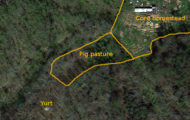Our
forest
pasture experiment has finally begun! Mark finished up the
first pasture on Friday and let out
our cockerels to poke around. We plan to let them
eat this pasture down to bare earth, then rotate them into a pasture on
the hillside. Once the chickens have moved on, we’ll sow a
combination of clover and buckwheat in the first pasture to prepare the
ground for a do-nothing
grain rotation.
When the buckwheat is ripe in the fall, we’ll rotate the broilers back
into the grain pasture to fatten them up for slaughter.
Although they’re not
built yet, we plan to have two additional pastures on the
hillside. We’ll rotate the chickens between these two pastures at
intervals, making sure that they never stay in one paddock long enough
to kill all the plants. We’re not quite sure how big these two
pastures will have to be, yet — hopefully, we’ll figure that out over
the next few weeks as we see how long it takes the cockerels to scratch
up their first pasture.
Rotation will be pretty
simple since the coop is at the junction of the three pastures and has
a door opening into each one. At night, we can close the chickens
in the coop, then open up whichever door we please to let them into a
new pasture the next morning.
Meanwhile, we’re putting
in some perennials so that the pasture will provide even more chicken
feed in the years to come. An Illinois
everbearing mulberry
is supposed to provide all of the food a flock of chickens needs for
two or three months in the summer; ours should start bearing in a
couple of years. We also planted two Nanking
cherries and an
unidentified bush cherry to provide more summer fruit.
We’ll continue to feed
our chickens while they’re on pasture until I work the kinks out of our
plan — I certainly don’t want them to be malnourished. But
hopefully the access to greenery and bugs will start cutting back on
our feed costs.
upgrading to a chicken bucket
waterer, the most
economical option for keeping clean water available for large flocks.

